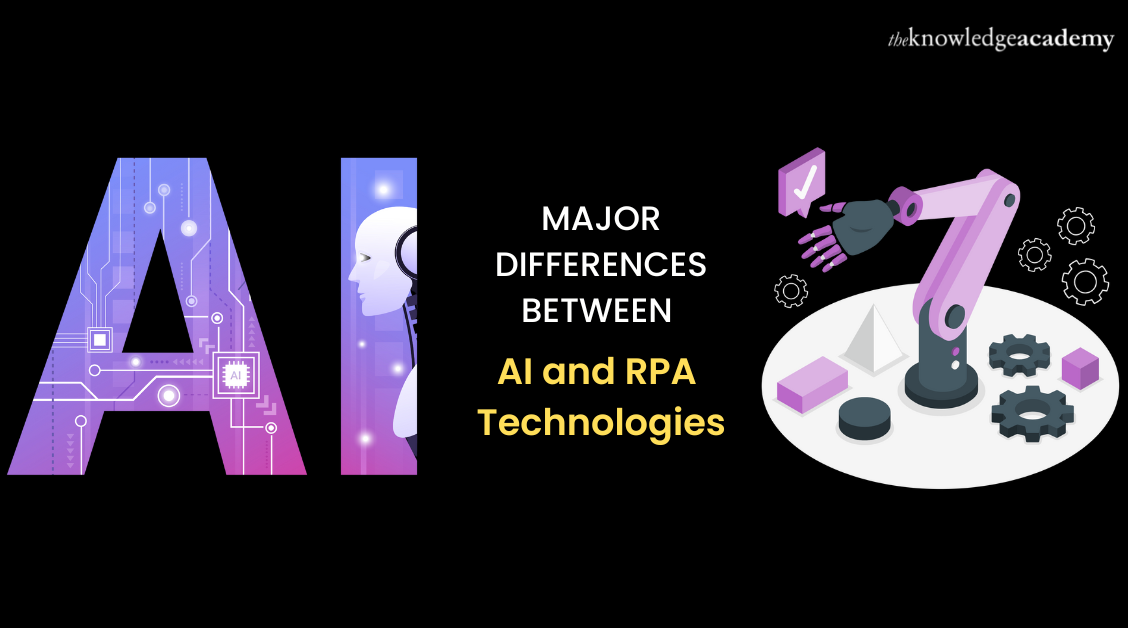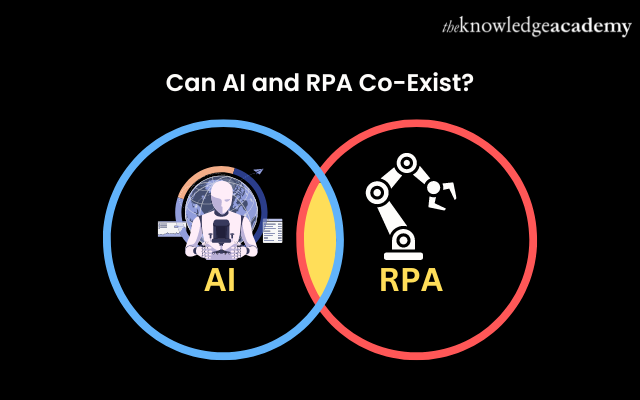We may not have the course you’re looking for. If you enquire or give us a call on 01344203999 and speak to our training experts, we may still be able to help with your training requirements.
Training Outcomes Within Your Budget!
We ensure quality, budget-alignment, and timely delivery by our expert instructors.

Artificial Intelligence (AI) and Robotic Process Automation (RPA) Technologies present a fine line of difference when it comes to the automation of organisational processes. Artificial Intelligence (AI) and Robotic Process Automation (RPA) help in the enhancing effectiveness and efficiency of organisational operations by helping save two of the most precious resources an organisation can afford: time and human effort.
According to Deloitte's State of AI in the Enterprise Survey 2020, 37% of organisations worldwide have deployed AI solutions, while according to Statista, 24% of organisations worldwide prefer RPA-based solutions for resolving cost and time issues.
In this blog, we will discuss why Automation & Artificial Intelligence are two of the most popular technologies in the world. Let's check out the differences between AI and RPA technologies below.
Table of Contents
1) Organisational importance of RPA
2) Organisational importance of AI
3) Major differences between AI and RPA
4) Can AI and RPA co-exist?
5) Real-world applications of AI and RPA
6) Conclusion
Organisational importance of RPA
RPA has become increasingly important for organisations in recent years due to its ability to automate repetitive, rule-based tasks and improve operational efficiency. Here are some of the ways through which RPA has become crucial for organisations:
Cost-saving: RPA can help organisations reduce costs by automating tasks that would otherwise require human resources. This can lead to significant cost savings over time.
Improved Efficiency: RPA can complete tasks much faster than humans, increasing efficiency and productivity. This allows human employees to focus on strategic and value-added activities.
Increased accuracy: Unlike humans, RPA bots have logic installed in them not to make errors. Increased accuracy can lead to higher productivity and guaranteed task completion of the duties assigned to the RPA bots.
Scalability: RPA can easily be scaled upwards or downwards depending on the volume of tasks involved in the organisation. For example, in peak periods, they can easily put up with the number of tasks heading their way without any external pressure, unlike humans.
Enhanced Customer Service: By automating processes, organisations can provide faster and more consistent customer service, leading to an overall enhanced customer service experience.
Improve your business operations by learning about one of the fastest-growing technologies today. Sign up for our Robotic Process Automation Training course now!
Organisational importance of AI
AI has become pivotal for organisations of all sizes and industries. Here are some reasons why AI has become important for organisations:
1) Enhanced efficiency and productivity: AI can automate routine tasks, freeing employees to focus on higher-level tasks that require human creativity and problem-solving skills leading to increased efficiency and productivity.
2) Improved decision-making: AI can analyse large amounts of data and provide insights to help organisations make better business decisions. This is especially helpful in industries such as healthcare and finance.
3) Personalisation: AI can help organisations personalise their interactions with customers, employees and other stakeholders. This can lead to better customer satisfaction and employee engagement.
4) Cost Saving: By automating tasks and improving efficiency, AI can help organisations save money. For example, AI can optimise supply chains, reduce waste and prevent fraud.
5) Competitive Advantage: Organisations adopting AI early on can gain a competitive advantage over those not. AI can help organisations stay ahead of their competitors by keeping ahead of the curve and providing insights to stakeholders they might not possess.
6) Innovation: AI can help organisations develop new products and services by identifying patterns and opportunities that humans may not have noticed.
Explore the world of Artificial Intelligence by learning the basics. Sign up for our Introduction To Artificial Intelligence Training now!
Major differences between AI and RPA
Stated below in tabular format are the major differences between AI and RPA:
|
Points of Difference |
AI |
RPA |
|
Definition |
AI is a field of computer science aiming to create intelligent machines to perform tasks that require human intelligence, like perception, reasoning, learning and decision-making. |
RPA is a software technology using robots or bots to automate repetitive, rule-based and routine tasks such as data entry, form-filling and document processing. |
|
Purpose |
AI solves computer problems, makes predictions and provides insights by analysing large volumes of data. |
RPA is used to automate repetitive and mundane human tasks, reduce errors and increase efficiency in business processes. |
|
Type of tasks |
AI can perform cognitive tasks such as natural language processing, image/speech recognition and decision-making. |
RPA is designed to perform routine, structured and rule-based tasks that follow a specific set of instructions. |
|
Technology used |
AI uses various technologies such as machine learning, deep learning, neural networks and natural language processing to simulate human intelligence. |
RPA uses software bots to automate tasks by following predefined rules and regulations. |
|
Data Processing |
AI can process unstructured and structured data and extract insights from it. |
RPA is limited to a structured set of pre-defined rules to follow and execute. |
|
Decision Making |
AI can make decisions based on data analysis and machine learning. |
RPA does not make decisions on its own and follows pre-defined processes to perform tasks. |
|
Human Intervention |
AI may or may not require human intervention, depending on the task they are assigned to execute. |
RPA may require human intervention to handle exceptions and errors that fall outside of the pre-defined rules. |
|
Examples |
Examples of AI include virtual assistants, image recognition, chatbots and predictive analytics. |
Examples of RPA include data entry, invoice processing, customer service and IT support. |
These are some of the key differences between AI and RPA. While both technologies are used to automate tasks, they differ in purpose, types of tasks, the technology used and decision-making capabilities.
Can AI and RPA co-exist?

Often used interchangeably for the same purpose of automation of mundane tasks in organisations, the question arises in many minds: Are AI and RPA the same?
The answer is a resounding no, as AI and RPA are distinct technologies with their strengths and limitations. However, their coexistence can bring significant benefits to an organisation.
One of the primary benefits of using RPA is that it allows organisations to automate repetitive, time-consuming tasks and is prone to errors. RPA bots can be programmed to perform various tasks such as data entry, file management and report generation, freeing employees to focus on higher-value tasks that require human-like cognitive abilities such as learning, reasoning and decision-making.
However, RPA has its limitations. It can only automate rule-based and well-defined tasks, and it cannot perform tasks that require cognitive abilities. This is where AI steps in. AI can complement RPA by enabling machines to perform tasks that require cognitive abilities.
For example, AI-powered chatbots can understand natural language and provide personalised responses to customer queries. At the same time, machine learning algorithms can analyse large volumes of data and identify patterns and insights that would otherwise be difficult for humans to detect. By combining RPA and AI, organisations can create intelligent automation tasks that handle various tasks and processes.
One area where RPA and AI can work together is in the field of predictive analytics. Organisations can use RPA to collect data from various sources and use machine learning algorithms to analyse the data and make predictions. For example, an organisation can use RPA bots to collect data on customer behaviour and use machine learning algorithms to predict which products or services will likely be in high demand in the future. This can help organisations make data-driven decisions and stay ahead of the competition.
Another area where the coexistence of RPA and AI is particularly beneficial is the field of process automation. Organisations can use RPA to automate repetitive, rule-based tasks and use AI to enhance the capabilities of RPA bots. For example, organisations can use RPA bots to extract data from invoices and use machine learning algorithms to classify data and identify anomalies. This speeds up the process, improves accuracy, and reduces the risk of errors.
Real-world applications of AI and RPA
As two rapidly evolving technologies, AI and RPA have the potential to revolutionise many industries. Here are some real-world applications of AI and RPA:
1) Finance and Banking: AI and RPA can automate a variety of financial and banking processes, including fraud detection, credit underwriting, customer service and compliance. AI algorithms can analyse large volumes of financial data to detect anomalies and patterns that may indicate fraudulent activity. At the same time, RPA can automate repetitive tasks such as invoice processing and reconciliation.
2) Manufacturing: AI and RPA can optimise manufacturing processes by automating routine tasks, improving quality control and predicting equipment failures. With AI, you can analyse production data to identify patterns and anomalies that may indicate a problem. At the same time, RPA can automate tasks such as data entry, inventory tracking and order processing.
3) Healthcare: AI and RPA can help healthcare providers to improve patient outcomes and streamline operations. AI can analyse patient medical records to identify patterns and correlations, while RPA can help automate administrative tasks such as patient registration and appointment scheduling.
4) Human Resources: AI and RPA can help streamline HR processes by automating candidate onboarding, screening and payroll processing tasks. For example, AI algorithms can be assigned to analyse resumes and job descriptions to identify the most qualified candidates. At the same time, RPA can automate tasks such as data entry and record keeping.
Conclusion
Summing up, while there are differences between the meaning and purposes of Artificial Intelligence (AI) and Robotic Process Automation (RPA), it is visible that both are related to each other. Organisations and industries have started taking advantage of the symbiotic relationship that AI and RPA have shown potential for and have started implementing both to increase the effectiveness and efficiency of operations.
Learn how to research strategy and design life cycle phases using AI. Sign up for Artificial Intelligence (AI) For Project Managers now!
Frequently Asked Questions
Upcoming Data, Analytics & AI Resources Batches & Dates
Date
 Introduction to AI Course
Introduction to AI Course
Fri 2nd Aug 2024
Fri 15th Nov 2024







 Top Rated Course
Top Rated Course



 If you wish to make any changes to your course, please
If you wish to make any changes to your course, please


